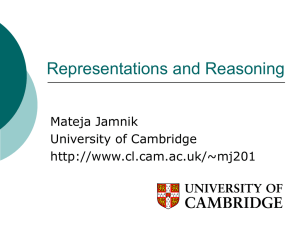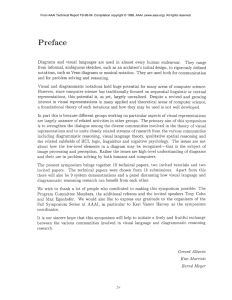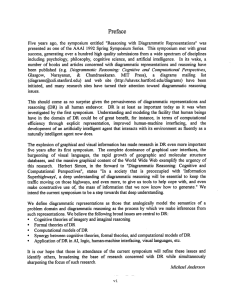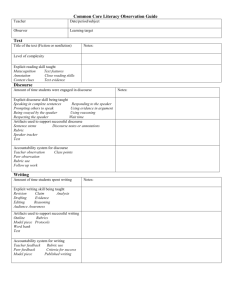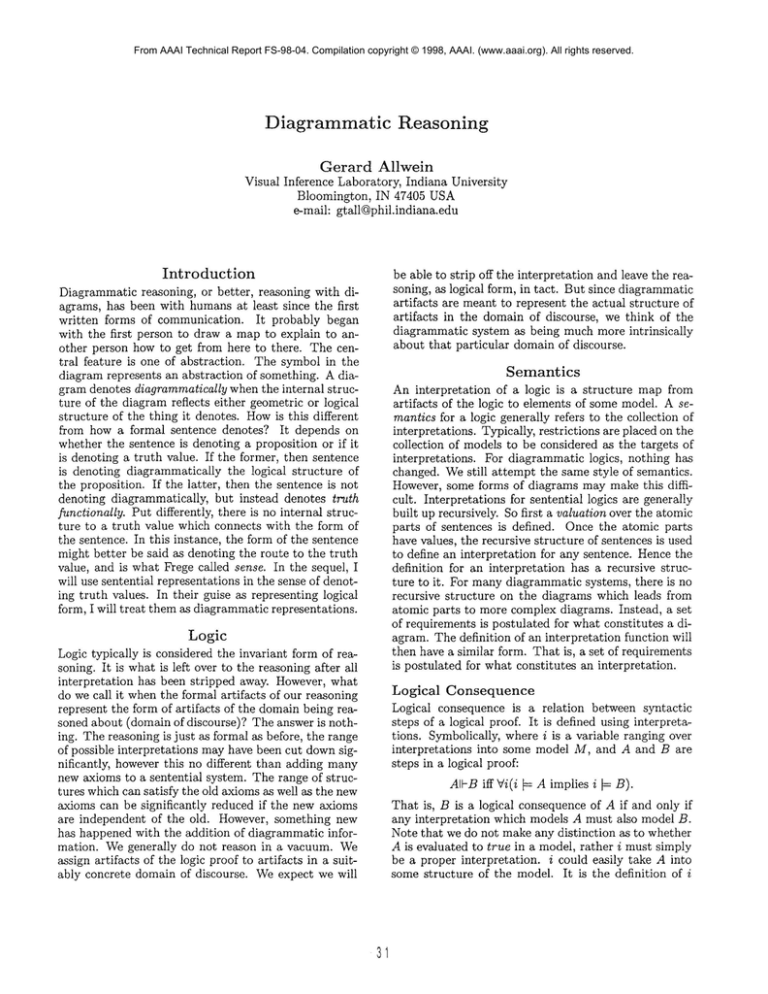
From AAAI Technical Report FS-98-04. Compilation copyright © 1998, AAAI. (www.aaai.org). All rights reserved.
Diagrammatic Reasoning
Gerard Allwein
Visual Inference Laboratory, Indiana University
Bloomington, IN 47405 USA
e-mail: gtall@phil.indiana.edu
Introduction
be able to strip off the interpretation and leave the reasoning, as logical form, in tact. But since diagrammatic
artifacts are meant to represent the actual structure of
artifacts in the domain of discourse, we think of the
diagrammatic system as being much more intrinsically
about that particular domain of discourse.
Diagrammatic reasoning, or better, reasoning with diagrams, has been with humans at least since the first
written forms of communication. It probably began
with the first person to draw a map to explain to another person how to get from here to there. The central feature is one of abstraction. The symbol in the
diagram represents an abstraction of something. A diagram denotes diagrammatically when the internal structure of the diagram reflects either geometric or logical
structure of the thing it denotes. How is this different
from how a formal sentence denotes? It depends on
whether the sentence is denoting a proposition or if it
is denoting a truth value. If the former, then sentence
is denoting diagrammatically the logical structure of
the proposition. If the latter, then the sentence is not
denoting diagrammatically, but instead denotes truth
functionally. Put differently, there is no internal structure to a truth value which connects with the form of
the sentence. In this instance, the form of the sentence
might better be said as denoting the route to the truth
value, and is what Frege called sense. In the sequel, I
will use sentential representations in the sense of denoting truth values. In their guise as representing logical
form, I will treat them as diagrammatic representations.
Semantics
An interpretation of a logic is a structure map from
artifacts of the logic to elements of some model. A semantics for a logic generally refers to the collection of
interpretations. Typically, restrictions are placed on the
collection of models to be considered as the targets of
interpretations. For diagrammatic logics, nothing has
changed. We still attempt the same style of semantics.
However, some forms of diagrams may make this difficult. Interpretations for sentential logics are generally
built up recursively. So first a valuation over the atomic
parts of sentences is defined. Once the atomic parts
have values, the recursive structure of sentences is used
to define an interpretation for any sentence. Hence the
definition for an interpretation has a recursive structure to it. For many diagrammatic systems, there is no
recursive structure on the diagrams which leads from
atomic parts to more complex diagrams. Instead, a set
of requirements is postulated for what constitutes a diagram. The definition of an interpretation function will
then have a similar form. That is, a set of requirements
is postulated for what constitutes an interpretation.
Logic
Logic typically is considered the invariant form of reasoning. It is what is left over to the reasoning after all
interpretation has been stripped away. However, what
do we call it when the formal artifacts of our reasoning
represent the form of artifacts of the domain being reasoned about (domain of discourse)? The answer is nothing. The reasoning is just as formal as before, the range
of possible interpretations may have been cut down significantly, however this no different than adding many
new axioms to a sentential system. The range of structures which can satisfy the old axioms as well as the new
axioms can be significantly reduced if the new axioms
are independent of the old. However, something new
has happened with the addition of diagrammatic information. We generally do not reason in a vacuum. We
assign artifacts of the logic proof to artifacts in a suitably concrete domain of discourse. We expect we will
Logical Consequence
Logical consequence is a relation between syntactic
steps of a logical proof. It is defined using interpretations. Symbolically, where i is a variable ranging over
interpretations into some model M, and A and Bare
steps in a logical proof:
AII-B iff Vi(i
1= A
implies i
1= B).
That is, B is a logical consequence of A if and only if
any interpretation which models A must also model B.
Note that we do not make any distinction as to whether
A is evaluated to true in a model, rather i must simply
be a proper interpretation. i could easily take A into
some structure of the model. It is the definition of i
31
which determines whether it can properly evaluate A.
Similarly statements hold for B in relation to i.
Generally, we expect our logics to be sound, that is
properties must a diagram have in order to be a diagram
of some target. In the quote below, taken from Shimojima's thesis, representations are diagrams, but they
could really be anything that represents, Le., abstracts
from, a target of representation (domain of discourse).
A f- B implies All-B.
In words, if B is provable from A using logical rules,
then B must be a logical consequence of A. Again,
there is no distinction as to whether A and B refer to
formulas or diagrams. It could even be the case that
A is a formula and B is diagram or visa versa. All
that matters is that i be of sufficient weight so as to
fix values of the syntactic artifacts as model theoretic
entities. Soundness is what enables us to use logic with
confidence that our reasoning will not go astray.
And it is also a good to have completeness, which is
the opposite of soundness:
All-B implies A f- B.
In words, this says that if B is a logical consequence of
A, then we can prove that B follows from A in the logic.
This is what gives us confidence that our intuitive feel
of the logic captures the essential nature of the models
over which we would like to reason.
Geometic Consequence
This form of consequence relation was developed by Isabel Luengo in her dissertation Diagrams in Geometry
(Indiana University, 1995). We will say that i --+ i' obtains if the interpretation i' extends the interpretation
i. By extends, it is meant that i' is capable of interpreting more syntactic artifacts than i but must agree with
i on all of the artifacts i is defined over. B is a geometric consequence of A iff every interpretation i of A may
be extended to an interpretation i' of B. In symbols,
A
1= B
iff Vi(i
F A implies :li'(i -> i'
and i'
Constraint Hypothesis Representations are objects in the world, and as such they obey certain
structural constraints that govern their possible
formation. The variance of inferential potential
of different modes of representation is largely attributable to different ways in which these structural constraints on representations match with the
constraints on targets of representations.
In this work, a representation represents or indicates
information about a domain of discourse. A free ride results when an operation changing a representation into
another representation results in a side effect of further
inferences being drawn. An example that is used is of
houses on opposite sides of a river. Diagrammatically,
given the further information about an additional house
between two others, one can add a house between two
other houses in the diagram. The result indicates that
the additional house is now opposite houses on the other
side of the river. This fact cannot be drawn from the
original diagram or from the act of adding the house.
The information comes about because the constraints
of the diagram for houses matches the constraints in
the target domain of the actual houses and river. This
can be pictured schematically (again from Shimojima's
thesis):
{e l , ... ,en}
indicate
F B)).
Geometric consequence is what underwrites our ability
to add information to diagrams. As can be seen from
the definition, any logical consequence relation is also
a geometric consequence relation, but not visa versa.
Here, a diagram can be thought of as a path through
a proof. At various points, information is added to the
diagram. This notion is very much akin to the notion of
a variable set in mathematics, Le., a set whose elements
change in response to the change of a function.
Free Rides
Atsushi Shimojima in his dissertation, On the Efficacy
of Representation (Indiana University, 1996), worked on
the problem of why does a diagram appear to be such
an efficient manner of representation. Surely, most of us
"see" relationships in a diagram. However, the ability
to add information to a diagram sometimes results in
information which does not appear to be present in the
original diagram or the addition but springs from both
as seen after the addition has been made.
Shimojima started out by postulating a constraint
hypothesis. Put quickly, it attempts to postulate what
{al,'
constraints
r
'r' ,am}
I
.8'
indioate;
- - - - - - " a'
constraints
supports
8 v - - - -••
s~
where 8 v represents the initial diagram, 8~ is the same
as 81) except for the change av to 8 v . The {al' ... ,am}
stands for the the syntactic artifacts in the diagram.
They indicate the pieces of information {8 l , ... , 8 n }
about the domain of discourse. Because there is a
matching of the constraints in the domain of discourse
(represented by the upper left to right arrow) with the
geometric constraints in the diagram (represented by
the lower left to right arrow), the diagrammatic artifact a' now indicates another piece of information, 8'.
-32


